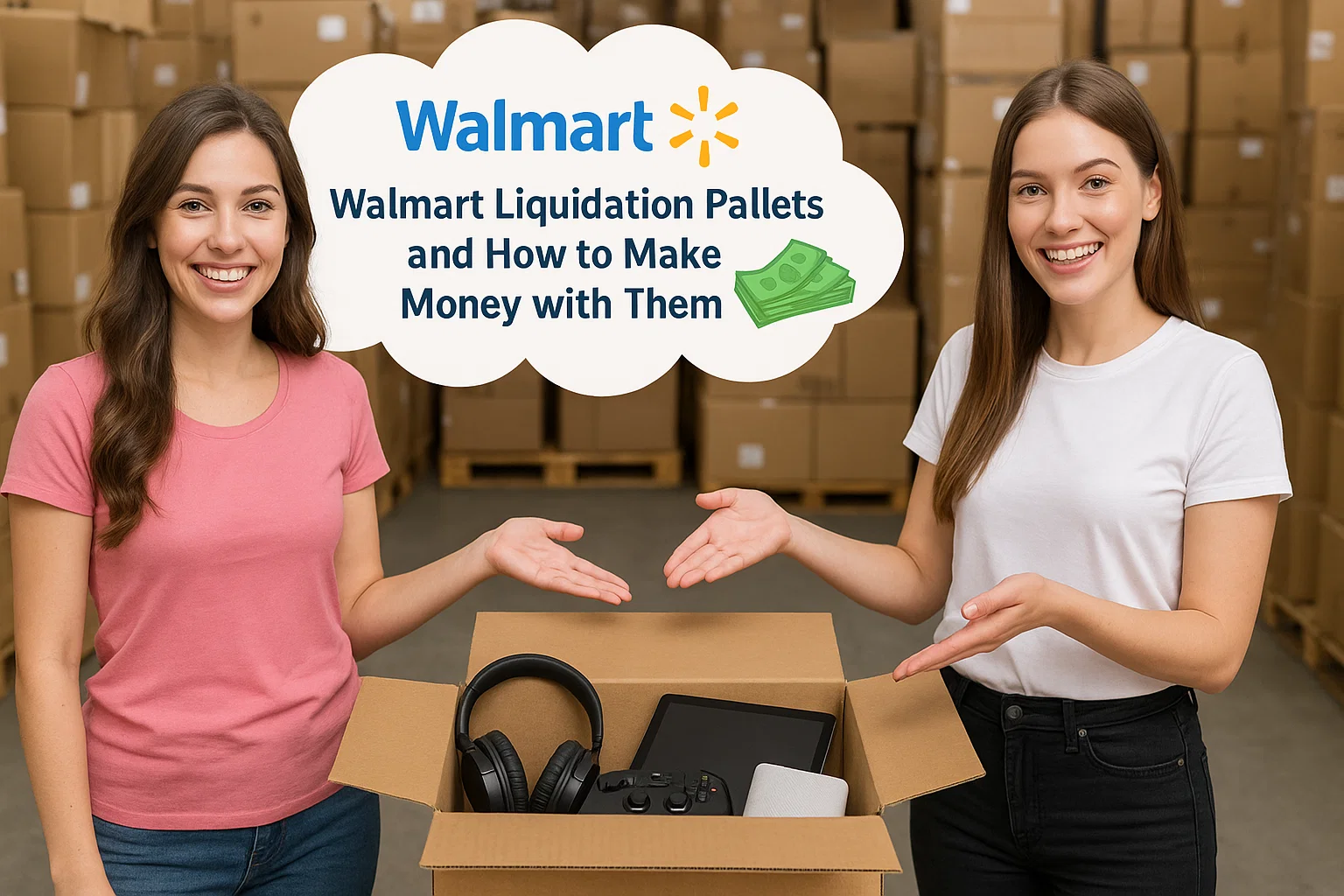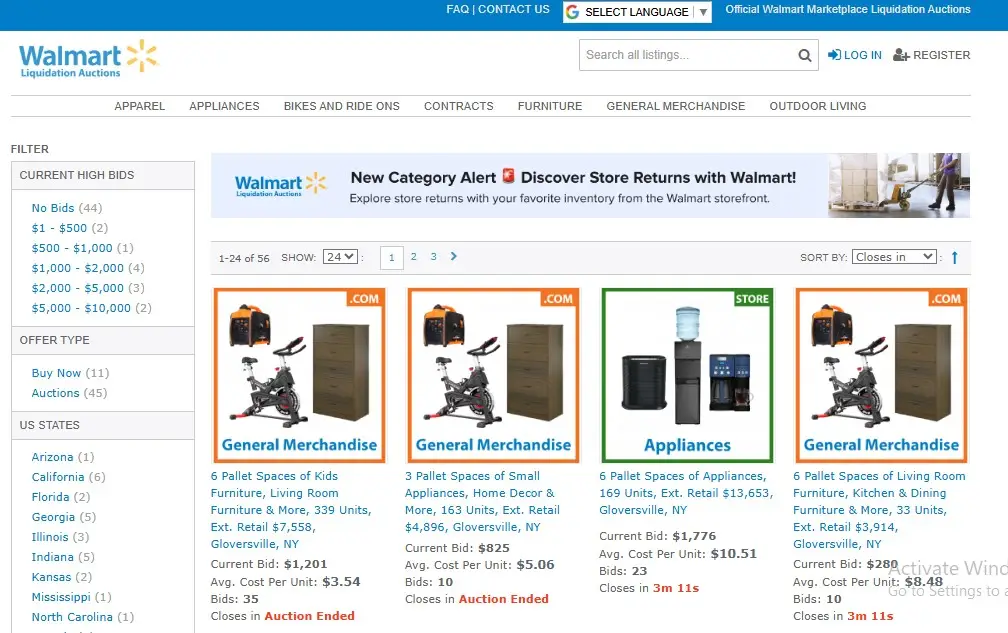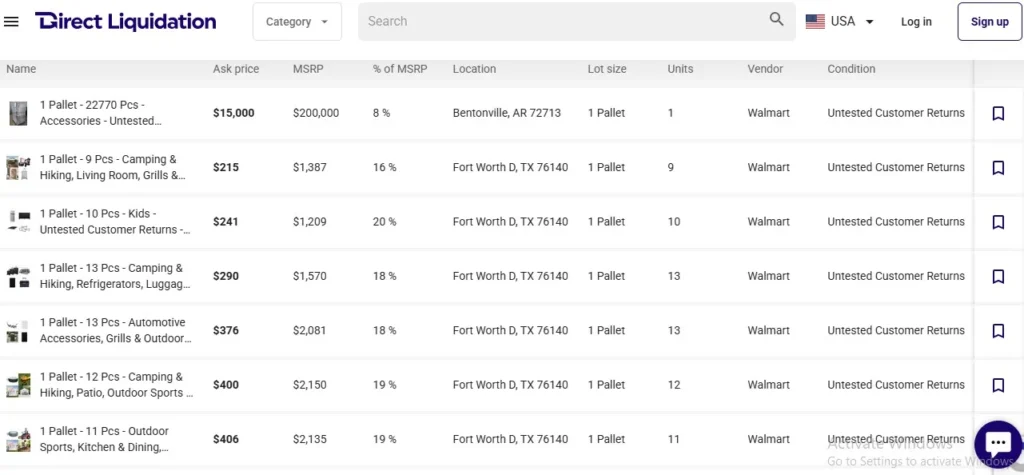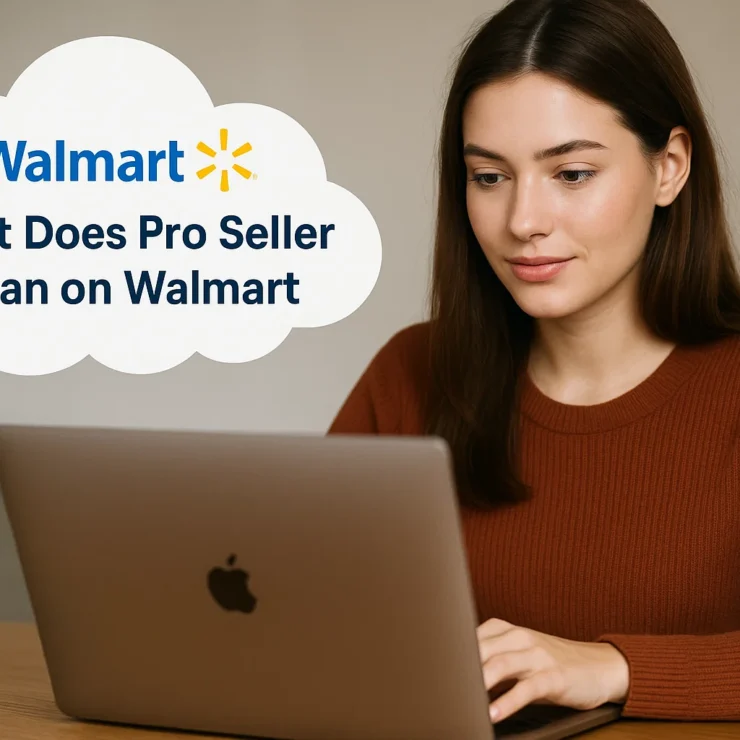In 2025, Walmart liquidation pallets have become one of the most profitable and accessible ways for entrepreneurs and resellers to make money online. With the global eCommerce resale market projected to surpass $350 billion by 2027, buying liquidation pallets—bulk lots of returned, overstocked, or shelf-pulled merchandise from retail giants like Walmart—offers incredible opportunities for anyone looking to build a steady income stream or scale a resale business.
Whether you’re a seasoned eBay or Amazon seller, a local store owner, or simply someone looking to start a home-based business, Walmart liquidation pallets can serve as a goldmine of profitable items—from electronics and apparel to furniture and home goods.
In this guide, we’ll cover everything you need to know about Walmart liquidation pallets in 2025—what they are, how to buy them, where to find the best deals, and how to turn them into consistent profit. You’ll also learn insider tips, key risks, and strategies to ensure you get the highest return on every pallet you invest in.
Let’s dive in and explore how you can turn Walmart’s excess inventory into your next big business opportunity.
Stay ahead of important selling dates in 2025 with our guide on Walmart Seller Key Event Dates.
What Are Walmart Liquidation Pallets?
At its core, a Walmart liquidation pallet is a bulk lot of returned, overstocked, or shelf-pulled merchandise sold through Walmart’s official liquidation channel. These items—ranging from electronics and furniture to apparel and home décor—are bundled together and auctioned off to resellers at a fraction of the original retail price.
Key Components & Why They Exist
Customer returns: When items are returned—sometimes for minor cosmetic issues—they may not go back on store shelves. Instead, they are bundled into liquidation pallets.
Overstock / excess inventory: Product lines that didn’t sell as expected or seasonal goods that must be cleared out are also sent to liquidation.
Shelf pulls / clearance items: Items being replaced or removed from shelves for new models or packaging may end up on pallets.
Because the retail chain needs to recoup value and clear space, these pallets become a source of deeply discounted merchandise for business buyers. For example, the official Walmart Liquidation Auctions marketplace states that lots may include “customer returns, excess inventory and refurbished bulk lots” offered up to truckload size.
What You Might Get
The composition of a pallet can vary widely:
A pallet might consist of high-value electronics, premium home appliances, or gently used items.
Alternatively, it may include large quantities of lower-value goods such as seasonal toys, basic apparel, or home goods that need sorting before resale. Sellers report that some lots have as much as 35% of items needing repair, missing parts, or simply not resale-ready.
Because of this variability, manifest (detailed lists of included items) are often available and critical for assessing value and risk.
How This Works From Walmart’s Perspective
By bundling and selling these items via liquidation auctions:
Walmart recovers some of the cost of returns or unsold goods instead of destroying/internally disposing of them.
The company avoids warehousing old or returned stock indefinitely.
Resellers gain access to brand-name merchandise at heavily discounted rates—often resulting in substantial profit potential when handled correctly.
Learn what it takes to become a Walmart Pro Seller and unlock exclusive benefits for 2025 and beyond.
Quick Start Checklist
Legal Requirements
Obtain a resale certificate or seller’s permit from your state
Complete business registration (LLC or sole proprietorship)
Apply for a sales tax ID number
Get an EIN (Employer Identification Number) from the IRS (required if hiring employees)
Financial Setup
Prepare $1,000–$5,000 in startup capital for initial inventory purchases
Open a separate business bank account
Allocate a budget for shipping costs ($46–$500 per pallet depending on volume)
Maintain a reserve fund for slow-moving or unsold inventory
Logistics and Space
Secure at least 400 sq. ft. of storage space for pallet receiving and sorting
Have a pallet jack or furniture dolly for moving pallets
Set up shelving or bins for organized inventory storage
Arrange access to a vehicle capable of transporting pallets (or budget for freight delivery)
Sales Infrastructure
Create a Facebook Marketplace seller account
Maintain an eBay seller account with positive feedback history
Set up payment processing options (PayPal, Venmo, Zelle, etc.)
Implement an inventory tracking system (at minimum, a spreadsheet)
Prepare a photo setup for item listings (smartphone with good lighting)
Knowledge and Research
Learn to read and interpret manifests for evaluating pallet contents
Understand product categories that perform well in your target market
Conduct pricing research using completed eBay listings
Perform competitor analysis on local Facebook Marketplace sellers
Professional Accounts
Register for Walmart Liquidation Auctions
Create a B-Stock Solutions buyer account
Get access to Direct Liquidation and other major platforms
Build relationships with local liquidation warehouses
Discover how influencers can partner with Walmart to promote products and earn through the Walmart Creator Program.
Where to Buy Walmart Liquidation Pallets
Walmart Liquidation Auctions (The Official Source)
If you’re looking for genuine Walmart liquidation pallets, this is where the trail starts. Walmart Liquidation Auctions is Walmart’s official business-to-business (B2B) resale site. To register, you’ll need a valid resale certificate — this confirms you’re a legitimate reseller, not just flipping random goods on a whim.
Here, you can bid on everything from single pallets to full truckloads (typically 24–26 pallets per load). Bidding often begins at just $1, with prices rising as the competition heats up.
Expect to find pallets full of electronics, small appliances, apparel, toys, home improvement items, and more, often valued between $400 and $3,000 per pallet, depending on what’s inside.
The best part? Transparency. Each lot usually comes with a manifest that lists every item inside — including reasons for return, such as “wrong item,” “customer remorse,” or “minor defect.” This means you’re making informed choices instead of gambling on mystery pallets.
Pro tip from resellers: inspect before you invest. While big names like BULQ make buying easy online, seeing pallets in person (when possible) helps you avoid surprises and ensures you’re getting solid resale potential.
Not sure what to list? Discover this year’s hottest Walmart best sellers and learn how to choose high-demand, profitable products for your store.
B-Stock
B Stock is like the headquarters of liquidation marketplaces — it’s the platform that actually runs Walmart Liquidation Auctions and dozens of other official retailer auction sites. When you use B-Stock, you’re not just accessing Walmart pallets — you’re entering a massive network of liquidation inventory from multiple top brands all under one roof.
Through B-Stock, you can bid on Walmart customer return pallets, Walmart overstock inventory, and even brand-new products directly from retail warehouses. The site brings together liquidations from major chains such as Amazon, Home Depot, Lowe’s, Target, and Best Buy, letting you browse and buy across multiple categories in one simple dashboard.
One of B-Stock’s biggest strengths is trust and security. The platform is designed for verified business buyers and only lists inventory coming directly from the retailers themselves — not from middlemen or resellers who might have already sorted through the products. That means the chance of being scammed is extremely low. You also get access to clear manifests, accurate product descriptions, and responsive customer service if any issue arises.
Think of B-Stock as the ultimate liquidation marketplace — like a wholesale superstore for Walmart and other major retailers. With a single account, you can source goods across multiple industries, whether you’re reselling electronics, clothing, furniture, tools, or general merchandise. This variety is a huge advantage if you’re looking to grow your resale business from a small side hustle into something that brings in steady monthly income.
B-Stock hosts a constant stream of Walmart liquidation auctions, with products in all types of conditions — from brand new and unopened items to customer returns and shelf pulls. The platform has auction locations across the United States and Canada, and even several hubs in Europe and Asia, giving you flexible buying and shipping options. You can purchase individual pallets or full truckloads, depending on your budget and storage space, with many listings offering nationwide or international delivery.
Explore how the Walmart Brand Portal streamlines brand management and boosts your Walmart marketplace success.
Direct Liquidation
Direct Liquidation is one of the most established liquidation marketplaces, trusted by resellers for over a decade. The platform lets you buy Walmart customer return pallets and surplus inventory directly at wholesale prices, often far below retail value — and without the stress of competitive auctions.
For those who prefer stability and predictability, Direct Liquidation’s fixed-price model eliminates the uncertainty of bidding. You simply choose your pallet or truckload, review the detailed manifest, and buy instantly.
Each lot includes a complete manifest showing item names, quantities, and conditions, allowing you to calculate your potential profit (ROI) before purchasing. Inventory ranges from small boxes to full truckloads, covering product categories like electronics, clothing, home goods, furniture, tools, and general merchandise. Prices typically range from $1,000 up to $9,000 depending on size and contents.
What sets Direct Liquidation apart is its transparency and reliability. Every listing includes clear photos, product details, and sourcing information so you know exactly where the items come from. There are no hidden fees, and the price you see is the price you pay.
The company has sold over 35 million items, liquidated more than $1.7 billion in retail value, and earned thousands of positive reviews from small and large buyers alike.
Another plus — Direct Liquidation is committed to sustainability. Unsellable goods are responsibly recycled or donated, helping reduce landfill waste and support communities.
Whether you’re just starting out or scaling up, Direct Liquidation makes it easy to grow. You can begin with a single pallet and move up to multiple truckloads per week once your business expands.
In short, it’s a go-to choice for resellers who value honesty, detailed information, and consistent access to affordable Walmart liquidation inventory — without the guesswork of auctions.
Interested in launching your own brand? Our guide to Walmart’s Private Label program explains the process and benefits of building a unique product line.
How Much Do Walmart Liquidation Pallets Cost in 2025
Let’s move beyond theory and get into the actual figures — where the rubber meets the warehouse floor.
A typical Walmart liquidation pallet will run somewhere between $200 and $1,000, depending on what’s inside. For lots packed with higher-value items (electronics, power tools, premium returns) you’ll sometimes see pallets priced up to $2,900.
When you scale up to full truckloads (commonly 24–26 pallets or more), the total purchase cost can climb to $10,000 to $50,000, again heavily dependent on product categories, item conditions, manifest details, shipping, etc.
But here’s the thing: the sticker price isn’t everything. What counts more is the effective cost per individual item (once you break down a pallet) and what you can realistically resell those items for.
Let’s look at examples from actual resellers:
One vet buyer (we’ll call him “Chloe”, who’s been doing this since around 2015) regularly spots $600 mystery pallets (mixed returns, overstock, etc.) and still turns profit even after disposing or discounting damaged goods.
Clothing pallets: Chloe reports some loads at about $250 for roughly 250 pieces — that’s about $1 per piece cost basis. He typically sees these loads triple in revenue when he sells via flea markets or bin stores (so turning ~$250 into ~$750 or more).
For general merchandise pallets (tools, small appliances, home-improvement items) in the $500–$800 range, the difference is you get higher-price units (many $40+ rather than lots of $15 items) which move quicker, recover costs faster, and produce 2× or more ROI in short timeframes.
For specialty pallets (electronics, premium tools, curated loads) in the $300–$550 range: they’re ideal when selling locally (Facebook Marketplace, local pickup) where shipping isn’t a barrier and buyers want category-specific items.
A smart way to evaluate is:
If a pallet’s manifest (or estimated retail value) is, say, $5,000, and you acquire it for $800 total (including freight), your margin plays out nicely if you can resell 50-75% of items at 50-75% of retail—giving you a buffer for the “junk” or unsellable items.
What to Factor In – Beyond the Purchase Price
When you’re looking at pallet buying, consider these additional cost & risk components, because they’ll greatly affect your margins:
Shipping/freight: Especially for full truckloads, the per-pallet shipping cost drops significantly when you move more units. One source noted shipping two pallets might cost ~$1,000 (~$500 each), whereas a full truckload might only distribute ~$46 freight cost per pallet.
Storage, handling & processing time: You’ll need space to receive, sort, inspect, test, clean, and list items. Labor/time counts.
Condition & repair: Not all items will be perfect. Some returns have missing parts, damage, or are defective. Expect a certain “loss rate” (e.g., 20-40% unsellable) depending on the pallet type.
Specialization matters: Resellers who focus on specific product categories (e.g., power tools, electronics, home goods, clothing) tend to perform better than generalists. Knowing your market means quicker turnover, better pricing, less risk.
Manifested vs unmanifested loads: A manifested pallet gives you a detailed item list and condition breakdown, which reduces risk (and often costs more). Unmanifested loads carry more risk but may come cheaper. Experienced resellers sometimes lean into lower-cost unmanifested loads once they have strong resale channels and risk tolerance.
If you approach Walmart liquidation pallets with the right mindset and systems, you can generate real profit. Here’s a summary:
Buy at $200–$1,000+ per pallet, or $10,000+ for truckloads.
Focus on items that sell at $40+ (not just lots of $5-10 filler).
Use manifests when possible, specialize in categories you understand.
Factor in all costs (shipping, storage, processing, disposal).
Hunt for that “shocker item” to cover your cost quickly.
Scale by buying more, lowering per-unit cost, and selling faster.
Used intelligently, this can go from side-hustle to a consistent income stream.
To fully understand Walmart Spark Review Program benefits, check out our in-depth 2025 guide created for marketplace sellers.
How Resellers Actually Make Money Selling Walmart Liquidation Pallets
Here’s where the rubber meets the road. You’ve secured your Walmart liquidation pallets, sorted through the merchandise, and now it’s time to turn that inventory into real profit. The key lies in finding the right resale channels that fit your time, effort, and income goals. Let’s explore the most effective ways to make money selling Walmart liquidation pallets in 2025.
The Bin Store Model (Sell Fast, Sell Volume)
Bin stores have become one of the hottest trends in the liquidation world — and for good reason. Since 2023, this retail model has exploded across the U.S., offering a simple yet profitable system to move inventory quickly and consistently.
How It Works:
Bin stores buy liquidation pallets (often from Walmart, Amazon, or Target), unbox the items, and place them into large bins where customers “treasure hunt.” Prices start high and drop daily throughout the week — for example:
Friday (Restock Day): $10–$12 per item
Saturday: $8
Sunday: $5
Monday: $3
Tuesday: $2
Wednesday: $1 Clearance Day
By the end of the week, any unsold items get cleared out at rock-bottom prices, making room for the next wave of inventory.
Profit Example:
Let’s say you purchase a Walmart pallet with 1,000 items at an average cost of $1 per unit. Even selling 70% of your inventory on $10–$3 days could bring in $4,000–$5,000 in revenue, while the $1 clearance day helps you move the remaining items at cost — freeing up space and cash for your next load.
Why It Works:
No need for fancy interiors — just bins and basic shelving.
High foot traffic driven by bargain hunters and the thrill of discovery.
You can move massive volume without individually listing every product online.
Bonus:
According to the National Retail Federation, 14.5% of retail purchases were returned in 2023 — over $743 billion worth of goods. Bin stores help keep this merchandise out of landfills while giving resellers a profitable, sustainable business model.
Facebook Marketplace & Local Facebook Groups (Low Effort, High Turnover)
If you’re not ready for a physical store, Facebook Marketplace is your best friend. It’s one of the most active platforms for reselling liquidation goods — especially bulky or local pickup items like furniture, home goods, and small appliances.
Real Example:
Frank and Madison, from the popular pallet-flipping channel, use Facebook Marketplace as their primary resale platform. Their strategy focuses on:
Selling items priced between $50–$100, which move quickly but still offer solid margins.
Using porch pickup for convenience — customers pay via Venmo or cash, no shipping hassles.
Why It Works:
No listing fees or platform cuts like eBay or Amazon.
Fast local sales and instant cash flow.
Ideal for oversized or fragile products that are costly to ship.
Pro Tip:
Join Facebook pallet reseller groups — these communities share supplier reviews, trending product info, and even bulk buyer opportunities. You can also trade slow-moving inventory for fresh stock.
eBay for High-Value & Niche Products
eBay continues to be a goldmine for resellers dealing with high-ticket items or niche products from Walmart liquidation pallets.
Think:
Electronics (laptops, tablets, gaming accessories)
Collectibles (Funko Pops, trading cards, vintage toys)
Power tools, brand-name home improvement gear
Seasonal decor and premium fashion items
Why It’s Profitable:
National and international reach — no need to rely on local buyers.
Built-in trust through buyer protection and reviews.
Auctions can push prices higher, especially for rare or in-demand items.
Expert Tip:
An expert reseller explains, “eBay is perfect when your local market feels saturated — you’re reaching outside your community and accessing global buyers.”
Pro Tip:
Bundle smaller items (like phone accessories or clothing) into lots for faster sales and fewer listings.
Whatnot Live Auctions (Engage and Sell Fast)
If you love interacting with customers and want to add some excitement to your reselling strategy, Whatnot is your go-to platform.
This live-streaming auction app has become incredibly popular for flipping Walmart liquidation items, especially mixed lots where the entertainment factor drives sales.
How It Works:
Start live auctions with items at $1 bids.
Showcase products in real-time while chatting with buyers.
Build hype, answer questions instantly, and encourage repeat purchases.
Why It Works:
Converts audience engagement into sales — viewers often bid higher just for the thrill.
Perfect for resellers with personality and showmanship.
Reduces listing time since you’re selling live in bulk sessions.
Resellers often find Whatnot a great outlet for odd items, collectibles, and “surprise box” lots that wouldn’t perform well as static listings.
Flea Markets & Local Liquidation Events (Offline Goldmine)
Don’t underestimate the power of old-school, in-person selling. Flea markets, swap meets, and community liquidation sales can be incredibly profitable for resellers who enjoy face-to-face interactions.
Why Offline Works:
Buyers can touch and inspect items, building instant trust.
No shipping or packaging costs.
Faster cash turnaround — often same-day profits.
Real Example:
Reseller Jacob reported that clothing pallets bought for just $250 often tripled in value when sold at local flea markets. The ability to negotiate and create personal connections makes this channel unbeatable for certain categories.
Pro Tip:
Display your best items upfront to attract foot traffic, and use signage to highlight deep discounts or brand names.
Learn how Walmart Connect works in detail by exploring our comprehensive guide designed for sellers at every level.
Common Pitfalls That Destroy Profits in Walmart Liquidation
Even with the best intentions, many beginners lose money flipping Walmart liquidation pallets because of avoidable mistakes. Understanding what not to do is just as important as learning how to buy and sell correctly. Here are the most common errors that can sink your profits — and how to avoid them.
Buying from Unverified or Shady Sources
One of the biggest pitfalls is purchasing pallets from random resellers on Facebook Marketplace or Craigslist. Many of these “resellers” cherry-pick valuable items and sell you the leftovers. Others may misrepresent what’s inside the pallet entirely.
Fix: Always buy directly from trusted liquidation platforms like Walmart Liquidation Auctions, B-Stock, or Direct Liquidation. These verified sources offer manifests, return reasons, and item conditions — ensuring transparency before you bid.
Ignoring the Manifest
New resellers often skip the step of reviewing the product manifest, which outlines everything in a pallet. Without this, you’re essentially gambling — you could end up with a pallet full of broken or low-value items.
Fix: Study the manifest carefully. Look for high-demand categories (electronics, home goods, tools) and calculate estimated resale value before buying.
Overpaying for Pallets
Many beginners get caught up in auction bidding wars and overpay for pallets that aren’t worth it.
Fix: Set a maximum bid based on ROI potential. Remember to include shipping, storage, and platform fees when estimating profitability.
Not Testing or Cleaning Items Before Resale
Selling untested or dirty items damages your reputation and leads to refunds or bad reviews.
Fix: Test all electronics, sanitize products, and clearly label conditions (new, open-box, refurbished).
Trying to Sell Everything Everywhere
A scattered selling strategy wastes time.
Fix: Focus on 2–3 platforms that align with your product type — e.g., Facebook Marketplace for bulk items, eBay for electronics, or Whatnot for collectibles.
Learn what the Walmart Buy Box is, why it matters, and proven strategies to win it in 2025
Final Thoughts: Walmart Liquidation Pallets
Walmart liquidation pallets present one of the most accessible and scalable ways to build a resale business in 2025. With low upfront costs, diverse inventory, and massive resale potential, these pallets can generate consistent profit — if approached strategically.
The key is to buy smart, not fast. Source pallets from verified platforms like Walmart Liquidation Auctions or Direct Liquidation, study manifests carefully, and always account for shipping and storage costs before bidding. Once you have your inventory, focus on the right sales channels — Facebook Marketplace for fast turnover, eBay for higher-ticket items, and Whatnot or local flea markets for volume sales.
Success doesn’t happen overnight, but with data-driven sourcing, product testing, and smart pricing, you can turn Walmart liquidation pallets into a sustainable income stream. Treat it like a business, not a side hustle — and your profits will follow.
Contact Us for Tailored Solutions – Stores Automation:
Ready to launch your Walmart store and unlock a passive income stream? At Stores Automation, we specialize in complete Walmart dropshipping automation services, managing everything from setup to operations — so you can focus on the profits while we do the work. Whether you’re a new seller or looking to scale, our team delivers fully managed solutions tailored to your goals. Contact us today at 302-204-8244 or email us at info@storesautomation.com. Sign up and Embark on the path to e-commerce success with Stores Automation








